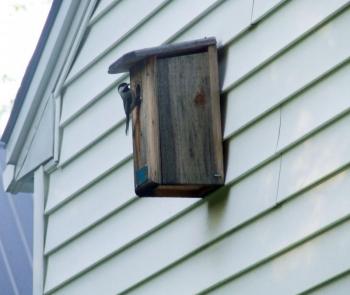Life and Death Outside the Kitchen Window
A pair of song sparrows has been feeding young in a nest they built in a shrub at the corner of the house outside our kitchen. Black-capped chickadees have nested again in the nest box that we have on the back of our garage. And early in the season, some European starlings had found a hole in the old tree above our neighbor’s house and rather secretively raised a family that is now noisily roaming the neighborhood, the fledgling’s calling harshly to their parents for food.
We are probably like many of you who may have a bird nest on or near where you live that you watch over as though the birds were part of your own family. Maybe it’s the American robin nest near the porch, the Eastern phoebe nest under the eaves of the deck, or the Northern cardinal nest in the bush that you can see from the living room window. Maybe you have a nest box in the back yard that is home to tree swallows or Eastern bluebirds. Or maybe you keep a close eye on the fate of the baby ospreys in a nest that you see every day on your way to work or the grocery store.
When you watch over a nest so closely it is hard not to feel a personal investment in seeing the endeavor through to a successful outcome—eggs hatched, chicks raised, and young fledged to maturity.
But of course there are many things that can go wrong.
The biggest thing that can go wrong is that the eggs or the young (or the adult bird, for that matter) can be killed by a predator. Here in our neighborhood the predators that we must keep an eye on the most about are free-roaming house cats. We’re not talking about our two cats, they’re re happy indoor-only cats. When you’re watching over a nest outside the kitchen window and are attuned to the alarm calls of nesting birds, you may discover that there are even more free-roaming cats in the neighborhood than the ones you knew about from the next door neighbor’s house.
And please understand that the familiar house cats are not native predators from North America but descendants of the species formally known as the wildcat that is a native of Africa, Asia, and parts of Europe.
In suburban settings, free-roaming house cats may be the predator most likely to kill nestling or adult birds. Add to that lots of other predators that birds have to watch out for. Mice and rats can be voracious predators of eggs and small nestlings. On many small seabird nesting islands around the world, rats have been accidentally introduced over hundreds of years. Many ships, at least in the old days but perhaps in modern times as well, unknowingly host stow-away rats. When one of these ships stops at an island, the shipboard rats sometimes go ashore and stay wherever they happened to be. If they find food and shelter, a new population of rats will flourish. In case after case, such rat populations have eventually eaten all the eggs and young and sometimes even the adult seabirds (especially small burrow nesting seabirds) and caused a breeding colony to disappear. Such heavy rat predation has led a species to the brink of extinction. Seabird colony conservation often has to start by wiping out the rat population on an island.
Many people are also surprised to learn that animals as cute as chipmunks and squirrels will take eggs and even eat young nestling birds. We happen to know this from experience when a robin nest we were watching from the living room window was unexpectedly raided by a local chipmunk.
Other birds are among the predators that nesting birds have to watch out for as well. Crows, common grackles, blue jays, and various hawks will take nestlings and fledglings, and some will take adult birds. Even hawks have to look out for other hawks, eagles, and owls. Great horned owls will sometimes swoop in at night on other hawks or owls and to make them a meal for their own young. Hawks will be happy to dine on another hawk’s nestlings if the nest is left unattended as happened last year when a bald eagle swooped down on the osprey nest at Hog Island and grabbed a sleeping nestling osprey.
It’s no wonder that we feel such a moment of triumph when we see the young birds successfully fly out from a nest like one of our human graduates receiving their diploma!
Jeffrey V. Wells, Ph.D., is a Fellow of the Cornell Lab of Ornithology. Dr. Wells is one of the nation's leading bird experts and conservation biologists and author of the “Birder’s Conservation Handbook.” His grandfather, the late John Chase, was a columnist for the Boothbay Register for many years. Allison Childs Wells, formerly of the Cornell Lab of Ornithology, is a senior director at the Natural Resources Council of Maine, a nonprofit membership organization working statewide to protect the nature of Maine. Both are widely published natural history writers and are the authors of the book, “Maine’s Favorite Birds.”































